
The Art of Gil Elvgren (Part Three)
Last part of our articles devoted to the works of Gil Elvgren (see first and second parts), today we will focus on the intermediate years and the end of Gil Elvgren's career.
In 1956, Elvgren finally convinced his family to move to Florida . This idea had been bouncing around in his head for almost four years, and the time seemed right to change his lifestyle and environment. Elvgren had many friends waiting for him in Florida.
Additionally, the climate in Illinois was not conducive to socializing and meeting for much of the year, whereas in Florida, quite the opposite was true. Elvgren quickly realized that he liked everything about his new adopted state .

No You Don't (1956)
Middle and final years
The Elvgrens found an ideal home on Siesta Key, and Gil built a fabulous split-level studio there. For the first four years, he had a studio apprentice named Bobby Toombs, who later became a recognized artist in his own right.
Once settled in Florida, Elvgren painted a large number of portraits, but not for the reason that most semi-retired illustrators do. Not aspiring to “fine art,” Elvgren simply enjoyed the people he met in his new community of Siesta Key. Many of his models were famous or became famous after posing for him. Myrna Loy , Arlene Dahl, Donna Reed, Barbara Hale and Kim Novak were just a few of Gil's models. In the 1950s and 1960s, seeing her portrait reproduced and published on a million Elvgren calendars provided a big boost to the career of an aspiring actress or starlet.
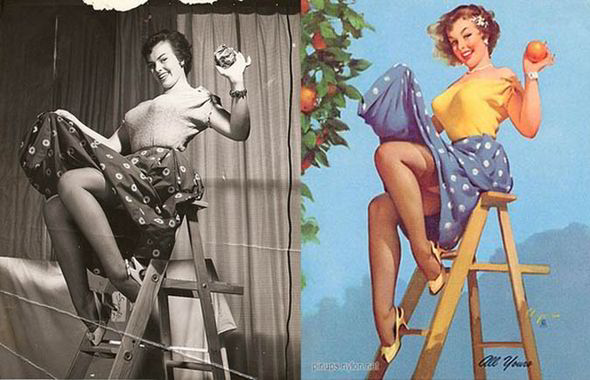
Myrna Loy
Although most artists make preliminary drawings or sketches of a subject before tackling an oil, Elvgren did not normally do this. However, he sometimes asked his apprentice to make such drawings if the latter was willing. When Elvgren decided to do something special with pin-up work, he would often do a study himself. In general, these drawings were quite small, measuring on average 50.8 x 40.6 cm (20" x 16"). Once he had completed the preliminary drawing of the pin-up called Bear Facts (or Bearback Rider).
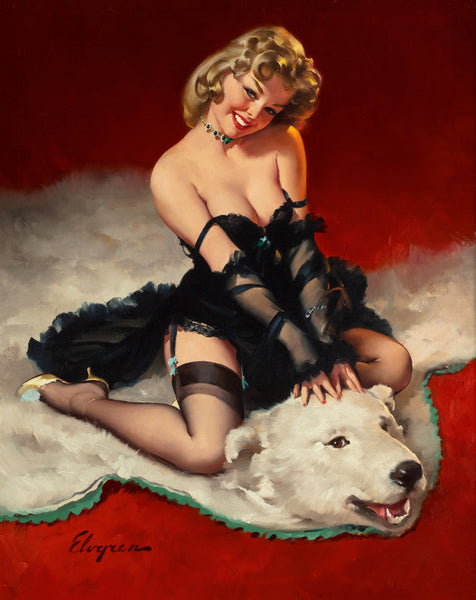
Bear Facts (1962)
In choosing his models, Elvgren did not limit himself to the starlets and actresses mentioned above. In the 1940s, he was particularly fond of Dayl Rodney and Pat Varnum, both in their late teens. Beginning in the mid-1950s, after he moved to Florida, model Myrna Hansen (who in 1954 became Miss USA) and her fifteen-year-old neighbor, Janet Rae, posed for him. In the 1960s, Rusty Allen and Marjorie Shuttleworth were his favorites.
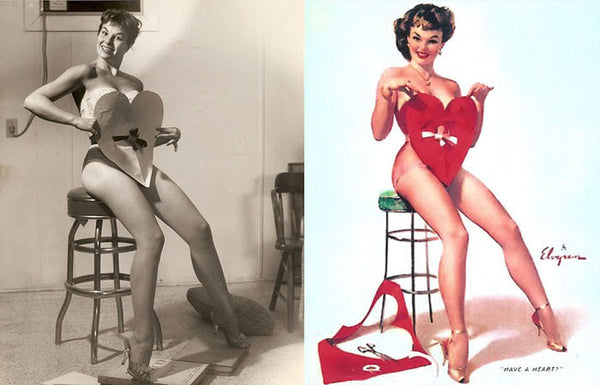
Myrna Hansen for “Have A Heart?” (1966)
In addition to a special contract for Napa Auto Parts at Brown and Bigelow each year, Elvgren was also responsible for doing one pin-up per year for Deitzler and Sylvania.
The Napa pin-ups that Elvgren did for Brown and Bigelow had to be a little more conservative than usual. To get around the problems, Elvgren always submitted a fully finished preliminary study, executed in oil on illustration board, to the company, which then presented it to Napa executives for approval. Only then would he paint the finished oil painting . In one such study, the fish the woman caught was between her spread legs. After reviewing the study, Napa executives asked Brown and Bigelow art director Buzz Peck to ask Elvgren to move the fish to the side, and here's how it appears in the final version.
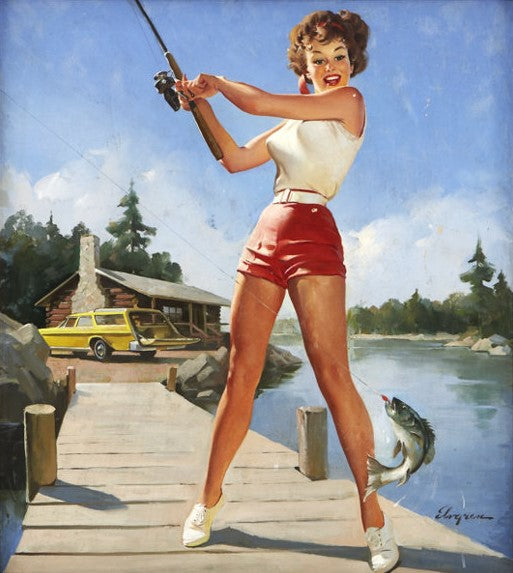
In 1963, Elvgren was honored with the publication of a unique card game called American Beauties (or sometimes Top Hat). Licensed by Brown and Bigelow, this game was the first to contain reproductions of fifty-three different Elvgren pin-ups, while previous games only illustrated one Elvgren Girl. Elvgren was the only Brown and Bigelow artist to be so honored; the only other pin-up artist to produce a set of fifty-three images was Alberto Vargas.
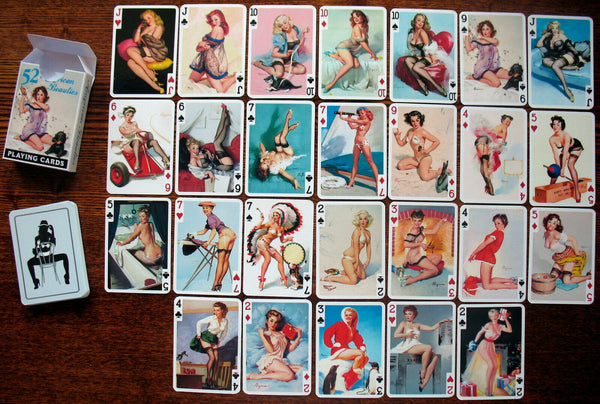
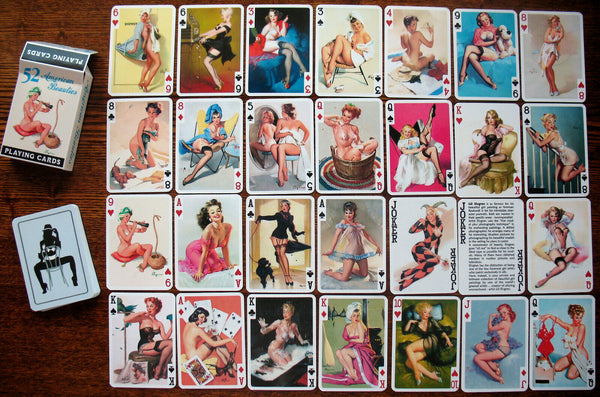
American Beauties (1963)
Amidst this great success, a terrible sadness came over the Elvgren household in 1966, when Janet died of cancer. After his death, Elvgren immersed himself even more in his work .
Amidst this great success, a terrible sadness came over the Elvgren household in 1966, when Janet died of cancer. After his death, Elvgren immersed himself even more in his work. He had reached the point in his career, after thirty years of painting, where he was relaxed enough to not worry about anything except creating the best possible image for any work. The result is that his pin-ups from the 1960s are the best designed, best painted and most beautiful works he ever made. Refreshing and magnetic, these Elvgren Girls captivated the viewer's attention with their sex appeal.
This was the best period of Elvgren's career, marked only by the grief of his wife's death. Over time, he ended up spending time with Marjorie Shuttleworth, one of his models in Sarasota.
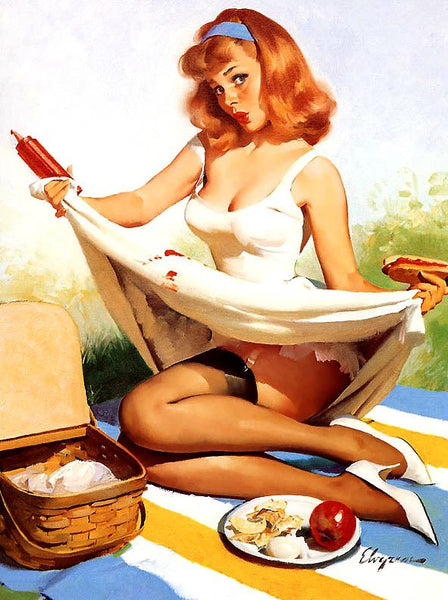
Red, White & Blue (1966)
Gil Elvgren's ability to capture the spirit and sensuality of American female beauty was unmatched. Her pin-ups were photos of real girls in real, everyday situations. They were a bit over the top at times, but they still worked.
When Elvgren was once asked what feature of a model interested him most, he replied: "A girl with highly mobile facial features capable of a wide range of expressions is the real gem. The face is personality .” The model was the most important factor in making a painting strong. He prefers young models (15 to 20 years old) who are starting their career, because they then have a freshness and spontaneity that are often lost after gaining experience and confidence.
Elvgren always planned each painting carefully. Starting with an idea, he would develop the visual situation and then choose the appropriate model for that specific setting. Then he would decide on the outfit, his studio background, props and lighting. Even the model 's hairstyle was an important factor: publishing a painting could take up to two years, and the girl's hairstyle had to be done in a style that was not timeless.
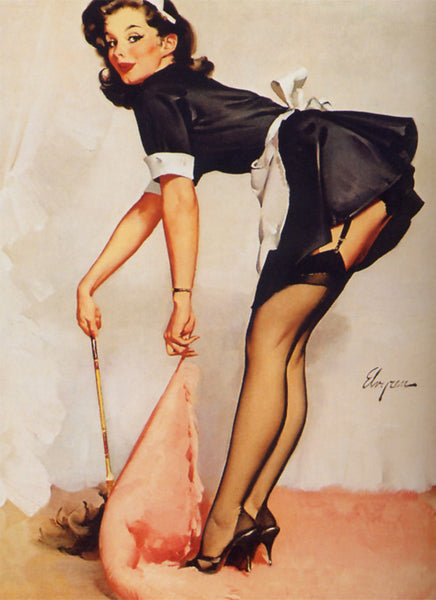
Clean Sweep (1963) [Available as a vintage metal plaque ]
The distinguishing mark of Elvgren's pin-ups from those of her contemporaries is that the Elvgren Girls looked like real people. At any time, the girl could come out of the picture and say hello or good evening or offer the viewer a cup of coffee, a drink or an invitation to some not-so-innocent fun. The Elvgren Girls had personality and spirit; they were lively beauties, friendly and overflowing with enthusiasm. They had sweet faces, but were also generously spoiled by nature. They could easily light a spark in anyone's eye and often had one of their own.
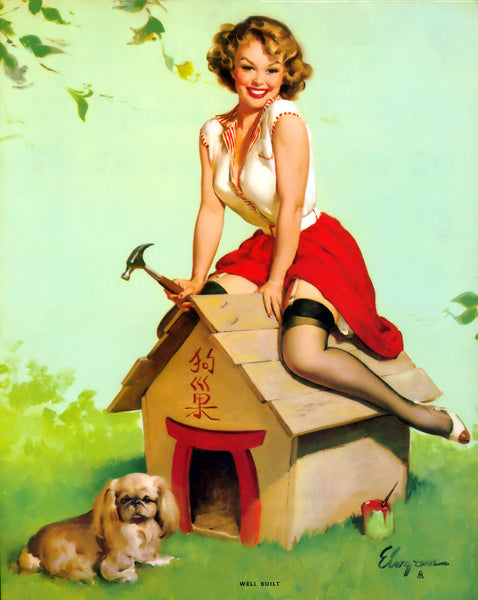
Well Built (1961) [Available as a vintage metal plaque ]
Conclusion
Gil Elvgren , a man who had spent much of his life enriching the lives of others, succumbed to cancer on February 29, 1980, at the age of sixty-five. In his studio on Featherbed Lane in Siesta Key, Drake found his father's final Brown and Bigelow pin-up, an unfinished yet still brilliant painting, reproduced and published here for the first time. Elvgren has been missed for nearly two decades, but his art and legacy endure. Celebrating and appreciating what he created will remain the best compliment and greatest honor we can give him today. And, without a doubt, 21st century art historians will recognize Gil Elvgren as a major and important contributor to 20th century American art .
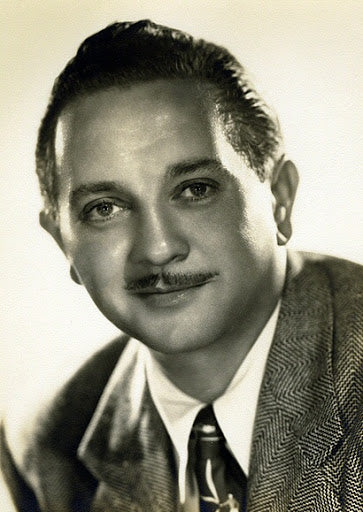
Return to part one of Gil Elvgren's art









Leave a comment